The Story of a Song
JR Hafer
Canada produces many of the best entertainers and most talented musicians; for example, Nickelback, Feist, Derek Miller and Blue Rodeo. During the "Big Band" and "Swing Era," from the 1920s through the 1940s, Canadians kept Americans dancing. Guy Lombardo, with his brothers; Percy Faith, Luigi Romanelli and many other Canadians, found success, in the USA.
There was a special excitement, in the 1920s, when a lively, infectious music, "Dixieland Jazz," was the rage. Dixieland segued into Big Band music, and the Swing Era. Everyone, in Canada, the USA and UK, danced to the upbeat music, and smooth crooning. Among the most popular orchestras were several from Canada. These orchestras included Red McKenzie and his "Mound City Blue Blowers"; Captain Plunkett's "Dumbbells" and the Romanelli Orchestra.
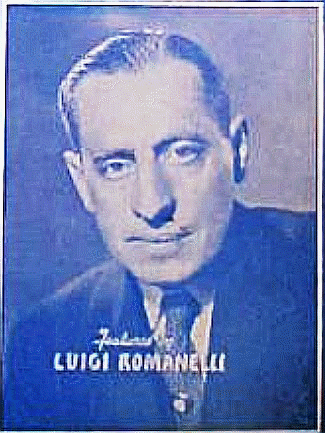


Luigi Romanelli (above), a violinist, performed on the streets of Toronto. He and dancer, George Weitz, worked Yonge at Bloor. Weitz achieved fame as producer of a series of Broadway reviews, "George White's Scandals." Romanelli made his vaudeville debut, in 1897, with Gladys Smith, from Toronto. She's better known as Mary Pickford. (Click on smaller photographs to enlarge and "back" to return here.)
Romanelli lead the first orchestra heard on radio. The live broadcast came via CKCA-AM and from Shea's Theatre, in Toronto. That was 1922. Not long after, the Romanelli Orchestra had its own live radio shows on the NBC Blue Network.
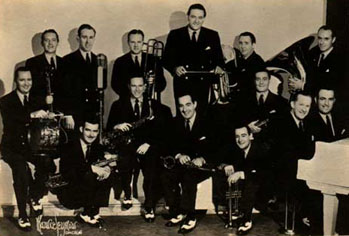
The Royal Canadians, about 1935
The Royal Canadians, lead by Gaetano Alberto "Guy" Lombardo, came from London, Ontario, in 1923. It was a top orchestra, for more than fifty years. The nucleus of the Royal Canadians formed in 1917, as the "Lombardo Brothers, Orchestra and Concert Company." Long, descriptive names were common, at the time. The long name ostensibly assured the audience would get a lot for its money.
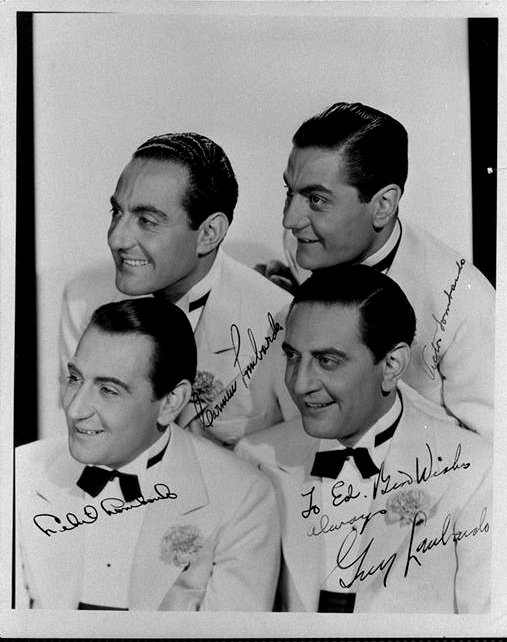
The act featured Guy, Carmen, Lebert and Victor Lombardo (above). Occasionally, sister, Elaine, joined to sing. Father, Gaetano, senior, a violinist, also performed off and on, with the orchestra. At the time, various family members commonly moved in and out touring acts. When John Mills, Jr., of the "Mills Brothers," passed away, in 1936, he was temporarily replaced by his father, John Sr., who stayed for twenty years.
After a performance in Cleveland, about 1923, the Lombardo Brothers Orchestra and Concert Company changed its name to the Royal Canadians. Ashton Stevens, of the Chicago "Tribune," wrote the Royal Canadians played "The Sweetest Music this Side of Heaven." The description stuck and became the slogan for the orchestra.
The Royal Canadians had several hits, including "I'll See You in My Dreams" and "Enjoy Yourself." They performed for New Year's Eve Parties, at the Roosevelt Hotel (1929-1959) and the Waldorf Astoria (1960-1976), both in New York City. CBS radio aired the "Party," from 1929 to 1979. On CBS television, the show ran from 1954 to 1979.
Ruth Lowe was among the Canadians making a name, in the USA. Born in Toronto, Ontario, on Friday, 12 August 1914, her passion for "Dixieland Jazz" and "Swing Music," developed while living in Los Angeles. In the early 20th century, California actively promoted migration. Come west, the state urged, paraphrasing Horace Greeley, to sunshine and success. The motion picture industry was the first to act. The elder Lowe, a traveling salesperson, bought the hype, moving Ruth and family to Los Angeles, where fortune, if not fame, awaited them.
In the late 1920s, the Lowe family returned to Toronto. A year or so later, the elder Lowe passed away, a victim of the then unstoppable pneumonia. Ruth, suddenly, was the sole and soul supporter of her mother, Pearl, and younger sister, Mickey.
There weren't many jobs for a 16-year old, supporting a family of three. Typically, a young woman might take in laundry or clean houses, and hope to marry. Ruth, optimistic and full of spirit, became a "song plugger."
Song plugging is a lost art, today. The work days were long, playing piano and promoting the sale of sheet music, at the Music Shop, on Yonge Street. Customers would select a piece of sheet music for Ruth to play. If the customer liked it, if Ruth "plugged it, well," they'd take it home to learn. Radio had yet to replace the piano as a focus of family life.
Maybe it wasn't such a bad job. George Gershwin plugged songs for Remicks, before becoming a superstar. A leading "Tin Pan Alley" publisher, Remicks sold more sheet music than did any other music store, in New York City.
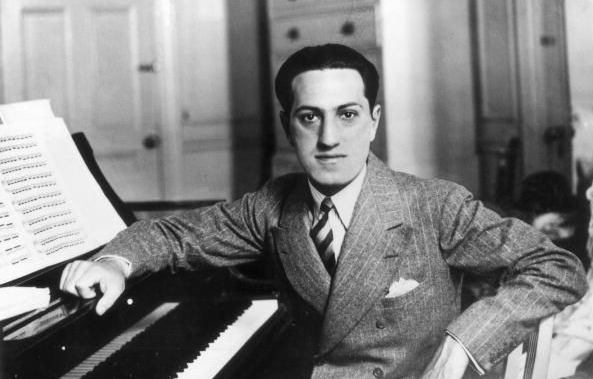


Gershwin (above, about 1925) had a best-seller, "Rialto Ripples," in 1917. "Swanee," with lyrics by Irving Caesar, debuted in "Demi-Tasse," a small revue, in 1920, but flopped when it came to sales. Once Al Jolson, the most popular singer of the day, used "Swanee," in "Sinbad," the 1921 Broadway musical, sheet music sales soared into the millions. Gershwin and Caesar were stars.
By day Ruth Lowe plugged songs. At night, she teamed, with her friend, Sair Lee, in a two-piano act. They performed in Toronto area nightclubs. Although common, at the time, two-piano acts were intricate, often involving mirrored illusions, many costume changes, elaborate and harmonically urbane arrangements. A successful two-piano act could hold audience attention for an hour or more.
Ina Ray Hutton was the older half-sister of singer, June Hutton. In the early 1930s, Ina was a chorus line dancer, on Broadway, appearing in "Melody" and the "Ziegfeld Follies." From 1934 to 1939, she led an all-girl touring orchestra, "The Melodears."
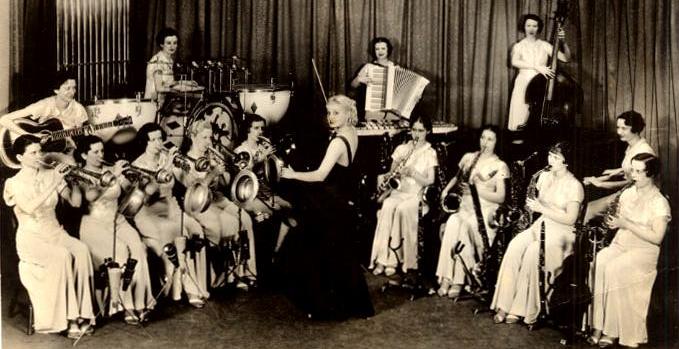 Ina Ray Hutton and the Melodears, about 1933
Ina Ray Hutton and the Melodears, about 1933
Before a 1935 appearance, in Toronto, "The Melodears" put out a short-notice call for open auditions; the band needed a replacement piano player and fast. Theirs had taken ill. Ruth Lowe got the one-night job. She impressed Hutton and became a regular, with the orchestra. At 21, Ruthie was a road musician.
On the road, Ruth met Harold Cohen, a Chicago music publicist, a song plugger, with status. In 1937, Ruth and Harold married. A year later, Harold Cohen died during surgery for a kidney illness.
At age 24, Ruth Lowe was a widow. Stricken with grief, she moved to her mother's third floor apartment, on Barton Street, in Toronto. She spent the days watching women and men strolling, in Christie Pitts Park, across from her home.
Watching the couples laughing, their eyes locked in love, deepened the loneliness and grief for Ruth. She declared, on paper, "I'll never smile again." The hook, for a hit song, took shape in the mind of the young widow.
She needed a diversion, to expel her grief. Strollers in the park provided the what she needed. The conduit, the expression, of her grief, was the song lyric. A song, a lyric, for all time, "I'll Never Smile Again," came from the diversion and expression.
Here are the words Ruth Lowe wrote for "I'll Never Smile Again,"
I'll never smile again until I smile at you
I'll never laugh again what good would it do
For tears would fill my eyes
My heart would realize that our romance is through
I'll never love again I'm so in love with you
I'll never thrill again
To somebody new within my heart
I know I will never start to smile again
Until I smile at you
Within my heart I know
I will never start to smile again
Until I smile at you.
The song captured the mood of the world. Daily life made the lyric compelling. Wartime casualties would top 72 million or 1-in-25 men, women and children; that's 3.7% of the world population, at the time. Too many survivors sensed they'd never smile again.
The song legitimized the grief. The words of Ruth Lowe gave solace to all, who lost loved ones. She provided a rallying point, a source of support that society, not only men, women and children, found reassuring. Her timing couldn't have been better.
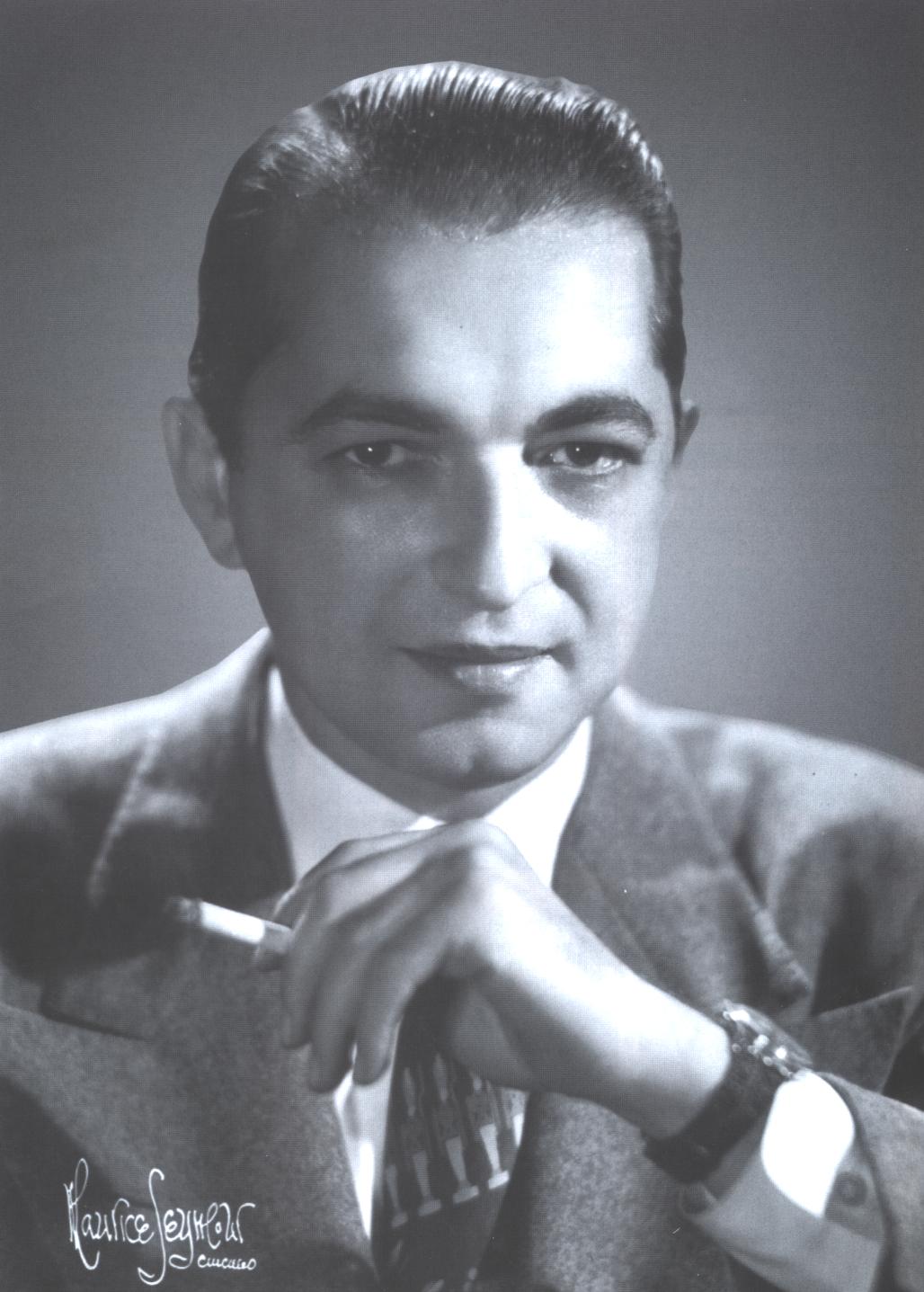


Ruth shared her song, with friend Percy Faith (above, about 1945). Though he emerged in the Big Band Swing Jazz era, Percy Faith is atypical. He refined orchestration styles. He smoothed jazz, set the boisterousness level lower. He produced lush, velvety music. He relied more on stringed instruments than did his contemporaries. "Mood Music," "Bachelor Pad Music" or "Elevator Music" best describe the work of Toronto-born Percy Faith.
How Faith arranged the Ruth Lowe song is a mystery. It was for his "Music by Faith," which ran on the Canadian Broadcasting Corporation (CBC), but no recording of his version exists. The smoky, easily bluesy lyric counters the lush style, of Faith; the simple, piano-based melody counters his intricate orchestrations. Still, the song debuted, on the CBC, which is what counts.
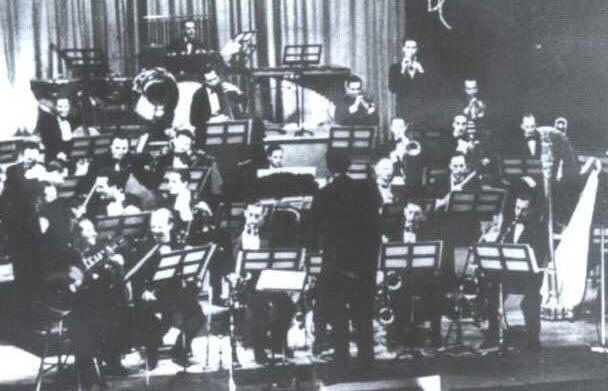 Percy Faith conducts CBC Orchestra, about 1940
Percy Faith conducts CBC Orchestra, about 1940
Ruth Lowe wasn't a one-hit wonder, simply a product of grief, as some claim. Nor did she camp out, on the steps of the Canadian National Exhibition Hall, waiting to thrust the sheet music into the coat pocket of Tommy Dorsey, as he passed, on his way to perform inside. Everyone knows musicians enter through the kitchen.
The facts are simple. As a song plugger and member of "The Melodears," Ruth Lowe had contacts. A friend of hers, a member of the Tommy Dorsey Orchestra, gave Dorsey the song.
Thomas Francis Dorsey and his older brother, James, are comparable to the brother-band "Oasis." Beginning about 1920, they rose from local musicians, in Pennsylvania, to the top orchestras. Tommy Dorsey and Jimmy Dorsey performed with Rudy Vallee, Vincent Lopez and Paul Whiteman. In 1934, they formed the Tommy and Jimmy Dorsey Orchestra. Endless bickering, as in "Oasis," including fist fights, split the band, in less than a year.
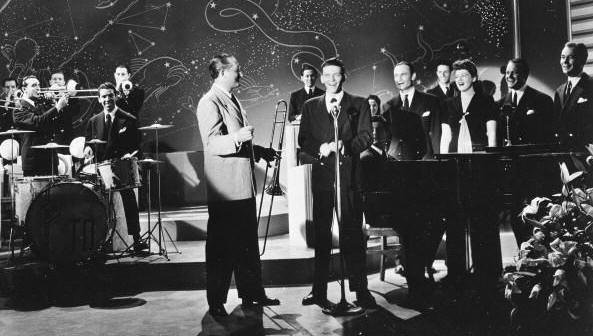
Tommy Dorsey Orchestra, about 1940;
Buddy Rich, on drums; Frank Sinatra, singing
On their own, the Dorseys had much success. Singers, Helen O'Connell and Dick Eberly, joined Jimmy (below, left, about 1935). Jimmy Dorsey devised an ABC format, which featured each singer and the orchestra, equally, on most every song. What varied was the order - ABC, ACB, CAB, CBA, BCA, and BAC. Much copied, the ABC format worked best for his own orchestra.
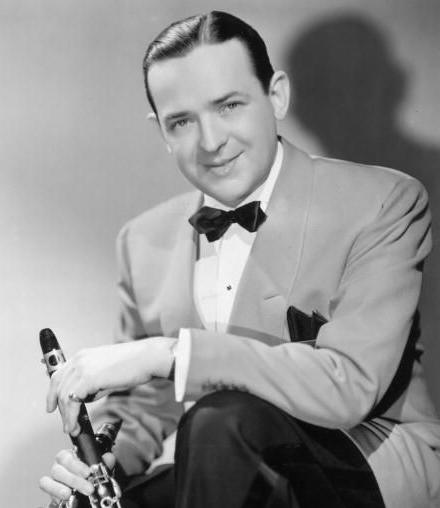

Tommy Dorsey (above, right, about 1940) had a knack for hiring exceptional musicians. His drummers included Gene Krupa, Louie Belson and Buddy Rich. The clarinet was a central instrument, of the Big Band era, although mostly silent, today. Tommy hired the best clarinet players, such as Buddy DeFranco, Johnny Mince and Peanuts Hucko. His choice of singers included Jo Stafford, Dick Haymes and Frank Sinatra.
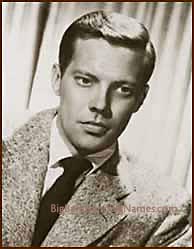


Dick Haymes, Jo Stafford and Frank Sinatra
Carl "Doc" Severinsen, leader of the "Tonight Show Band," during the Carson era, and arranger, Sy Oliver, were also part of the Tommy Dorsey Orchestra.
Although Sinatra sang with the Harry James Orchestra, his break came when hired by Tommy Dorsey. Sinatra claimed he learned breath control, watching Tommy play trombone. The first hit for Sinatra was the Tommy Dorsey Orchestra theme song: "I'll Never Smile Again," by Ruth Lowe.
Tommy Dorsey immediately saw the merit, of the Ruth Lowe song. He set his arrangers, Paul Weston and Axel Stordahl, to work. Sinatra and Jo Stafford alternated on lead vocal, backed by the "Pied Pipers," an eight-person harmony group, popular at the time. Dorsey used "The Sentimentalists," a small group of musicians, from his full orchestra, for the recording.
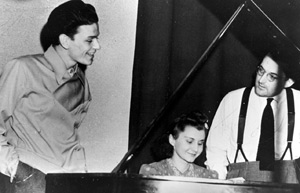


The collaboration on "I'll Never Smile Again" was singular. There were enormous egos, in the orchestra: Tommy Dorsey; drummer, Buddy Rich, and Sinatra, the young, cocky crooner from Hoboken, New Jersey. Despite the turmoil and, yes, more fist fights, they knew an opportunity when they heard it, and pulled together. (Above, Frank Sinatra, Ruth Lowe and Tommy Dorsey, about 1940.)
The hit recording, of "I'll Never Smile Again," came out on 23 May 1940. It seems Dorsey recorded several arrangements before settling on the released version. An instant hit, on jukeboxes, it was the first number one recording, on the first "Billboard Record Chart." The "Billboard Chart" ranks recordings, by popularity, setting the standard, to this day.
The strength of the Ruth Lowe song is in its adaptability. In 1959, Sinatra recorded a slow, dark, much sadder version, of "I'll Never Smile Again," arranged by Gordon Jenkins. Percy Faith and Tommy Dorsey had success using quite different arrangements. More than a hundred artists recorded "I'll Never Smile Again." The song was a hit for Perry Como; Canadian, Gisele McKenzie, and, mostly recently, Barry Manilow.
Ruth Lowe also wrote Sinatra's signature song, "Put Your Dreams Away," and "Too Beautiful to Last," among others. She was no one-hit wonder. No simple product of grief. Ruthie, the song plugger, was a bona fide success, as a songwriter.
Ruth Lowe ostensibly retired when she remarried in the middle 1940s. Her second husband, Nathan, was a good balance for her. He was a quiet, reserved low-key stockbroker. Ruth loved practical jokes, had an "impish way" and never met a stranger. Lowe continued to compose and play the piano.
In 1955, one of the most popular television shows, "This is Your Life," devoted a full segment to Ruth Lowe. She was celebrated, for an hour, by her friends and millions of viewers. American movie fans loved Canadians, Mary Pickford and Fay Wray. American music fans loved Ruth Lowe.
There was an effort to make a movie about the life of Ruth Lowe. Judy Garland was to star. Nathan, wanting to avoid publicity and attention, nixed the project.
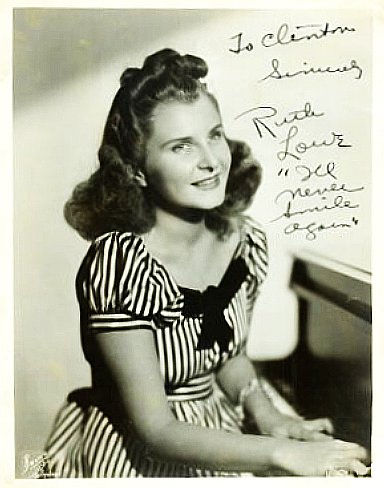


Ruth Lowe passed away on 4 January 1981. She received a Grammy Award, when the 23 May 1940 version of "I'll Never Smile Again," entered the Grammy Hall of Fame, in 1982. The American Hall of Fame inducted her posthumously. The Canadian Walk of Fame declined to recognize Ruth Lowe, in any way. "Too successful," said one wag, on learning of the snub, "and not around to stroke the small [sic] committee." In 2003, the Canadian Songwriters Hall of Fame belatedly inducted Ruth Lowe.
Surely, Ruth Lowe is smiling down, in her personable way, knowing those who remember and revere her. She's smiling, again and always!
In 1945, "La Vie en Rose" echoed the sentiment and mystical essence told by Lowe. "If the sky should fall into the sea," wrote Edith Piaf and Marguerite Monnot, "and the stars fade all around me. All the times that we have known here: I will sing a hymn to love." Imitation is the sincerest form of flattery.
Nothing in the pop rock era matches Lowe. The Bee Gees may come closest. "How can you mend a broken heart? How, can you stop the rain from falling down? How can you stop the sun from shining? What makes the world go round?" Even they don't use the lyric as a signature song.
Ruth Lowe gave voice to the grieving and downcast. She consoled herself and others. She confirms that in sadness, "I'll never smile again," there's hope, "Until I smile at you." Ruth Lowe does us well, in a large sense, when most serve only themselves, in a small way.
JR Hafer writes from his home in central Florida.
- Rosko
- Scott Muni
- Why and Wherefore
- Tell Me All About You
- Aging as a State of Mind
- WNEW Radio
- The Special Birthday
Click above to tell a friend about this article.
Recommended
- David Simmonds
- A Bit of a Smell
- Doggie Scent Abilities
- Nothwithstanding Doug Ford

- Jennifer Flaten
- Hockey Mom
- Home Improvement
- Home-grown Return

- M Alan Roberts
- Ode to Officer Cole
- Big Fat Deal
- Pain Eaters

Recommended
- Matt Seinberg
- Traffic Cameras
- Mike Wade
- Moving

- Bob Stark
- Chara Incident
- Cricket Anyone?
- RIP Stompin Tom

- Streeter Click
- Radio Ads from Late 60s
- Hollywood Dreams
- Why Grub Street?

Recommended
- Jane Doe
- The Jazz Age
- The USA in 2017
- A Quality Guitar

- M Adam Roberts
- My Eraser
- Humble Pie
- Take Your Shot

- Ricardo Teixeira
- The Future
- Harmony
- The Unicorn





